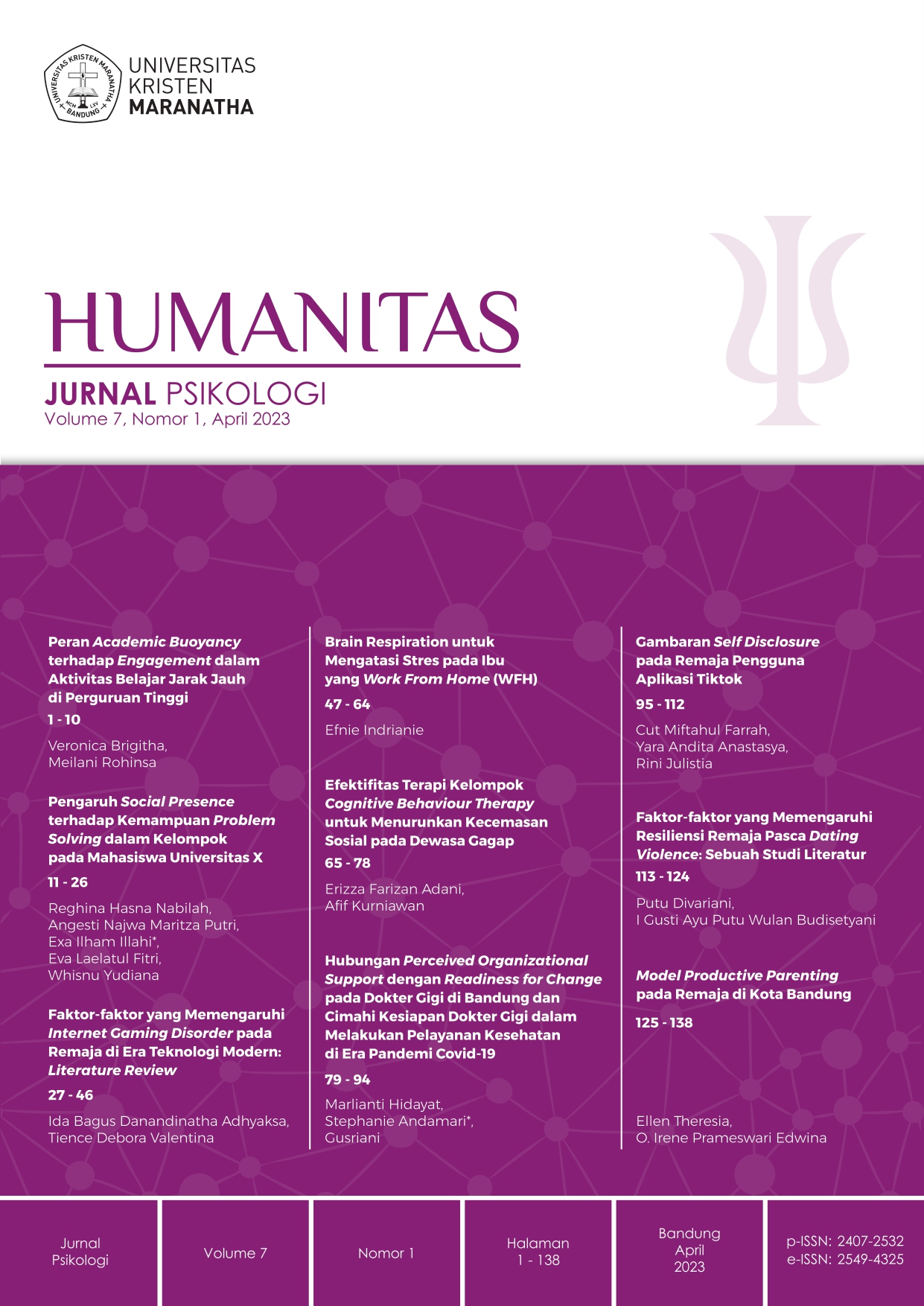The Role of Academic Buoyancy towards Engagement in Distance Learning Activities in Higher Education
Main Article Content
Abstract
Downloads
Article Details

This work is licensed under a Creative Commons Attribution-NonCommercial 4.0 International License.
References
Cahyadi, S., & Rohinsa, M. (2019). Peran teacher structure terhadap engagement melalui academic buoyancy pada siswa menengah atas. Jurnal Studia Insania, 7(2), 122-134.
Dahal, N., Manandhar, N. K., Luitel, L., Luitel, B. C., Pant, B. P., & Shrestha, I. M. (2022). ICT tools for remote teaching and learning mathematics: A proposal for autonomy and engagements. Adv Mobile Learn Educ Res, 2(1): 289-296. https://doi.org/10.25082/AMLER.2022.01.013
Fauziyyah, R., Awinda, R. C., & Besral, B. (2021). Dampak Pembelajaran Jarak Jauh terhadap Tingkat Stres dan Kecemasan Mahasiswa selama Pandemi COVID- 19. Jurnal Biostatistik, Kependudukan, dan Informatika Kesehatan, 1(2), 113-123
Finn, J. D., & Zimmer, K. S. (2012). Student engagement: What is it? Why does it matter? In S. L. Christenson, A. L. Reschly, & C. Wylie (Eds.), Handbook of research on student engagement (pp. 97–131). Springer Science + Business Media. https://doi.org/10.1007/978-1-4614-2018-7_5
Hadi, R. (2007). Dari teacher-centered learning ke student-centered learning: Perubahan metode pembelajaran di perguruan tinggi. Jurnal Pemikiran Alternatif Pendidikan, INSANIA, 12(3), 408-419.
Martin, A. J. (2013). Academic buoyancy and academic resilience: Exploring “everyday” and “classic” resilience in the face of academic adversity. School Psychology International, 34(5), 488-500.
Martin, A. J. (2014). Academic buoyancy and academic outcomes: Towards a further understanding of students with attention-deficit/hyperactivity disorder (ADHD), students without ADHD, and academic buoyancy itself. British Journal of Educational Psychology, Vol. 84.
Martin, Andrew., & Mars, Herbert. (2008). Academic buoyancy: Towards an understanding of students’ everyday academic resilience. Journal of School Psychology, Vol. 46(3).
Martin, Andrew., & Mars, Herbert. (2009). Academic resilience and academic buoyancy: Multidimensional and Hierarchical Conceptual Framing of Causes, Correlates and Cognate Constructs. Oxford Review of Education. Volume 3, No.3. London: Publisher Routledge.
Martin, Andrew et all. (2010). Longitudinal Modelling of Academic Buoyancy and Motivation: Do The “5Cs” Hold Up Over Time. British Journal of Educational Psychology. The British Psychological Society.
Martin, A. J., Yu, K., Hau, K.-T. (2013). Motivation and engagement in the “Asian Century”: A comparison of Chinese students in Australia, Hong Kong, and Mainland China. Educational Psychology. Publisher Routledge.
Pitzer, J., & Skinner, E. (2016). Predictors of changes in students’ motivational resilience over the school year. International Journal of Behavioral Development, 41(1), pp. 15-29.
Putwain, David W., Connors, L., Symes, W., & Douglas-Osborn, Erica. (2012). Is academic buoyancy anything more than adaptive coping? Anxiety, Stress, & Coping, 25, 349-358.
Rohinsa., Cahyadi., Djunaidi., & Iskandar. (2019). Peran Teacher Support terhadap Engagement Siswa Melalui Pemenuhan Kebutuhan Psikologi Dasar. Jurnal Psikologi, 15(2).
Rohinsa., Cahyadi., Djunaidi., & Iskandar. (2020). Effect of parent support on engagement through need satisfaction and academic buoyancy. Journal Utopia Y Praxis Latinoamericana, 25(6).
Rohinsa M. (2021). Reliabilititas dan Validitas Konstruk Academic Buoyancy di Indonesia. Humanitas, Vol. 5, no. 3.
Rohinsa, M., Gunawan, G., & Kadiyono, A. (2021). Penerapan Self Determination Theory: Peran Dukungan Orangtua Terhadap Academic Buoyancy Siswa Menjalani Pembelajaran Jarak Jauh. Journal An-Nafs, Vol. 6, no. 2. https://doi.org/10.33367/psi.v6i2.1806
Skinner, E. A., & Belmont, M. J. (1993). Motivation in the classroom: Reciprocal effects of teacher behavior and student engagement across the school year. Journal of Educational Psychology, 85. H. 571-581.
Skinner, E. A., Kindermann, T. A., & Furrer, C.J. (2009). Motivational Perspective on Engagement and Disaffection: Conceptualization and Assessment of Children’s Behavioral and Emotional Participation in Academic Activities in the Classroom. Educational and Psychological Measurement, 69; 493.
Skinner, E. A., & Pitzer, J. R. (2012a). Developmental dynamics of student engagement, coping, and everyday resilience. Handbook of Research on Student Engagement. (pp.21-44). New York : Springer Science.
Skinner, E. A., & Pitzer, J. R. (2012b). Handbook of Research on Student Engagement, 21–44. Newyork, NY : Springer Science.
Thomas, Christopher L., & Allen, Kristie. (2020). Driving engagement: Investigating the influence of emotional intelligence and academic buoyancy on student engagement. Journal of Further and Higher Education, Vol. 45.

